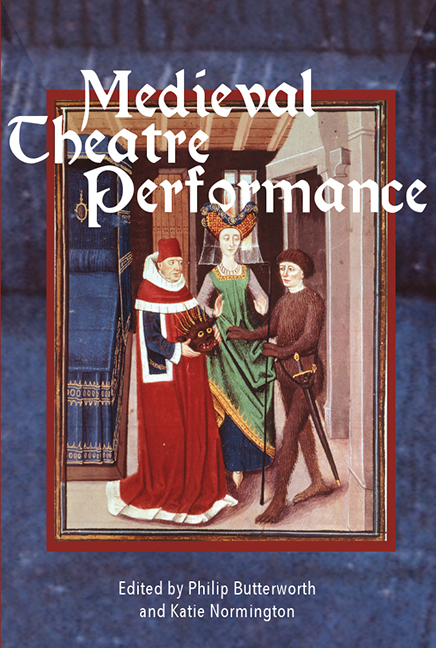Book contents
- Frontmatter
- Dedication
- Contents
- List of Illustrations
- Contributors
- Abbreviations of Principal Sources Cited
- Introduction
- Synopses
- 1 From Archive to Repertoire: The Disguising at Hertford and Performing Practices
- 2 Walk, Talk, Sit, Quit? On What Happens in Netherlandish Rhetoricians’ Plays
- 3 Performing Intrusions: Interaction and Interaxionality in Medieval English Theatre
- 4 Player Transformation: The Role of Clothing and Disguise
- 5 Pavilioned in Splendour: Performing Heaven in Fifteenth-Century Florence
- 6 Living Pictures: Drama without Text, Drama without Action
- 7 Performer-Audience Relationships in Fifteenth- and Sixteenth-century Danced Spectacles
- 8 Decadance in the Late Middle Ages: The Case of Choreomania
- 9 Writing, Telling and Showing Horsemanship in Rhetoricians’ Farce
- 10 Inanimate Performers: The Animation and Interpretive Versatility of the Palmesel
- 11 ‘lyke unto a lyvelye thyng’: The Boxley Rood of Grace and Medieval Performance
- 12 The Mechanycalle ‘Ymage off Seynt Iorge’ at St Botolph's, Billingsgate, 1474
- Bibliography
- Index
4 - Player Transformation: The Role of Clothing and Disguise
Published online by Cambridge University Press: 21 August 2018
- Frontmatter
- Dedication
- Contents
- List of Illustrations
- Contributors
- Abbreviations of Principal Sources Cited
- Introduction
- Synopses
- 1 From Archive to Repertoire: The Disguising at Hertford and Performing Practices
- 2 Walk, Talk, Sit, Quit? On What Happens in Netherlandish Rhetoricians’ Plays
- 3 Performing Intrusions: Interaction and Interaxionality in Medieval English Theatre
- 4 Player Transformation: The Role of Clothing and Disguise
- 5 Pavilioned in Splendour: Performing Heaven in Fifteenth-Century Florence
- 6 Living Pictures: Drama without Text, Drama without Action
- 7 Performer-Audience Relationships in Fifteenth- and Sixteenth-century Danced Spectacles
- 8 Decadance in the Late Middle Ages: The Case of Choreomania
- 9 Writing, Telling and Showing Horsemanship in Rhetoricians’ Farce
- 10 Inanimate Performers: The Animation and Interpretive Versatility of the Palmesel
- 11 ‘lyke unto a lyvelye thyng’: The Boxley Rood of Grace and Medieval Performance
- 12 The Mechanycalle ‘Ymage off Seynt Iorge’ at St Botolph's, Billingsgate, 1474
- Bibliography
- Index
Summary
court clothing was […] a symbolic medium in the later Middle Ages, both within and beyond ritual. Expansively and expensively marked with mottos, heraldic signs, occulted signatures, symbolic colours, and allegorical messages, the courtier's dress was a visual manifesto for its wearer.
Susan Crane's observation regarding the importance of clothing to late medieval court life identifies how the choice of attire brought together symbols of status, household affiliation, and sub textual message to project the identity of the wearer as a type of ‘visual manifesto’. The rise of the importance of clothing in this period was due to a number of developments which meant that the fifteenth century onwards saw new modes of supply, production and distribution which affected clothing, along with the manufacturing of other products. Trading routes to the Far East which supplied silks were re-established during this time, and the flow of ideas on fashioning garments from raw cloth expanded as cultural exchange deepened through greater transmission with Europe, India, and Africa. As Rosenthal observes, clothing was greatly affected by this new trading and cultural exchange:
textiles and trims were acquired in local, urban, and international markets, and individual identities were formed no longer solely according to regional, economic, and political dictates but also in accordance with social, aesthetic, and industrialized processes that embraced both global techniques and individual preferences.
In this new market economy fabric and clothing were commoditised and were part of a fresh exchange of cultures and techniques. The court of Henry VIII, notorious for its love of fashion, displayed the European influences introduced by his wives. Katherine of Aragon brought the Spanish farthingale (a hooped petticoat) and from her time in France, Anne Boleyn initiated the drapery of the square-necked bodice, while Anne of Cleves transported the Flemish leg-of-mutton sleeves.
- Type
- Chapter
- Information
- Medieval Theatre PerformanceActors, Dancers, Automata and their Audiences, pp. 76 - 92Publisher: Boydell & BrewerPrint publication year: 2017



